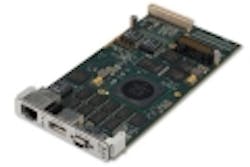Demands in the military for smaller, lighter electronic connectors could push changes in longstanding military specifications
Electronic connectors for power and data in aerospace and defense applications are shrinking in size and weight in response to demand for soldier-worn electronics, unmanned vehicles, and other applications where small size and weight are solid requirements. The problem, however, involves longstanding military specifications -- particularly for the standard military circular connectors that link electronics boxes to other boxes or devices.
These mil-spec MIL-DTL-38999 circular connectors resist the effects of shock and vibration, salt spray, dust and dirt, as well as moisture and humidity, yet increasingly they are too large for some of the military's smallest platforms.
"Most mil/aero people not in the connector business take a look at systems electronics, and all they see are these big, honkin' circular connectors, which weigh enormous amounts," says John Binder, military and aerospace industry manager at connector designer Hypertronics Corp. in Hudson, Mass.
"Those circular connectors do have great shock-and-vibe capability, but you are using up so much weight and real estate that eventually those will have to be replaced," Binder says. "You need to design to mil standards, but how do you change the mil standards?"
Binder points to the newest generations of unmanned aerial vehicles (UAVs) as prime examples of today's military applications that are driving electronic and electro-optical connector technology.
Unmanned vehicles are where it starts to change," Binder says. You don't want a lot of hardware to keep these in place, like thumb screws and bolts, but the mindset of the manned aircraft engineer hasn't hit that yet. This whole process of where UAVs are going is really going to change dramatically how aircraft are built in the future."
Institutional change in the military connector industry will come slowly, he cautions. "It won't happen overnight; this has been the standard for about 50 years," Binder says. "In five years we might see it. That will be the direction we tend to go, as an industry."
Hypertronics specializes in small, rugged connectors that link components inside subsystems boxes. Its flagship product is a hyperboloid contact shaped like a basket of wires. Each wire is a conductor, and together these wires grab and hold connector pins to prevent problems from shock and vibration.
The company also is designing larger box-to-box connectors based on the hyperboloid approach that Binder says may help drive changes in connector mil-specs in the future.
The military's growing need for small, lightweight, and rugged connectors also is driving developments at Fischer Connectors in Alpharetta, Ga. The company has introduced the Fischer LandForce connector as part of the company's UltiMate military connectors. These devices withstand nuclear, biological, and chemical environments are designed for soldier systems where size and weight is critical.
These devices also have relatively short plugs to make them small, easy to handle, and useful for applications in tight or restricted spaces. These connectors may help revolutionary the future soldier's uniform by enabling military contractors to focus on further down sizing and reducing the dimensions of the equipment they design, company officials say.
When it comes to power connectors, one company is trying to re-invent the aircraft interconnect to reduce the potential for mis-connects and other reliability issues. Custom Electronics Inc. in Oneonta, N.Y., is using bus-bar interconnects to replace hundreds of power connectors on military aircraft.
On the V-22 tiltrotor aircraft alone, bus-bars from Custom Electronics have replaced from 200 to 260 conventional power connectors, says Ken Brandmier, director of product development at Custom Electronics. "We can apply a really durable bus bar installation with fewer connection points," he says.
A bus bar is a conductor with powder coatings. Heating activates them and causes a cross-linking action. "It's difficult to mis-wire a bus bar," Brandmier says. This approach can reduce life cycle support because unlike traditional wire connectors and wire harnesses, the bus bar does not move around under stress to cause cracks or breaks.
Rugged electronic and optical connectors
AbelConn LLC, New Hope, Minn., 763-533-3533, www.abelconn.com
Accel Connectors Inc., Temecula, Calif., 951-296-9435, www.accelconnectors.com
Advanced Interconnections Corp., West Warwick, R.I., 401-823-5200, www.advanced.comAirBorn, Addison, Texas, 972-931-3200, www.airborn.com
American Conec Corp., Garner, N.C., 919-460-8800, www.conec.com
Amphenol, Wallingford, Conn., 877-267-4366, www.amphenol.com
AVX Corp., Myrtle Beach, S.C., 843-448-9411, www.avx.com
BTC Electronic Components Inc., Wake Forest, N.C ., 919-556-8900, www.btcelectronics.com
C&K Components, Newton, MA 02458, 617-969-3700, www.ck-components.com
Cinch Connectors, Lombard, Ill., 630-705-6000, www.cinch.com
Concord Electronics Corp., New York, N.Y., 212-777-6571, www.concord-elex.com
Connector Technology Inc., Somerset, N.J., 732-745-2880, www.connectech.com
Custom Electronics Inc., Oneonta, N.Y., 607-432-3880, www.customelec.com
DA-Green Electronics LTD., South River, N.J. , 732-254-2735, www.dgecorp.com
Delphi Connection Systems, Irvine, Calif., 949-458-3100, http://connectors.delphi.com
Delta Electronics Manufacturing Corp., Beverly, Mass., 978-927-1060, www.deltarf.com
Ericsson Inc., Plano, Texas, 972-583-2372, www.ericsson.com
FCI, Versailles, France, +33 (0)1 39 49 21 83, www.fciconnect.com
Fischer Connectors Inc., Alpharetta, Ga., 678-393-5400, www.fischerconnectors.com
Glenair Inc., Glendale, Calif., 818-247-6000, www.glenair.com
Harwin Inc., Salem, N.H., 603-893-5376, www.harwin.com
Hypertronics Corp., Hudson, Mass., 978-568-0451, www.hypertronics.com
Interconnect Devices Inc. (IDI), Kansas City, Kan., 913-342-5544, www.idinet.com
ITT Interconnect Solutions, Santa Ana, Calif., 714-557-4700, www.ittcannon.com
kSARIA Corp., Lawrence, Mass., 978-933-0000, www.ksaria.com
LEMO USA Inc., Rohnert Park, Calif., 707-578-8811, www.lemousa.com
Martec Limited, Swalecliffe, England, +44 (0)1227 793 733, www.martec.ltd.uk
Molex Inc., Lisle, Ill., 630-969-4550, www.molex.com
OFS, Avon, Conn., 860-678-0371, www.specialtyphotonics.com
Omnetics Connector Corp., Minneapolis, Minn., 763-572-0656, www.omnetics.com
Sabritec, Irvine, Calif., 949-250-1244, www.sabritec.com
Spectrum Control Inc., Fairview, Pa., 814-474-1571, www.spectrumcontrol.com
SV Microwave Inc., West Palm Beach, Fla., 561-840-1800, www.svmicrowave.com
Tempo-Textron, Vista, Calif., 760-598-8900, www.tempo.textron.com
TTI Inc., Fort Worth, Texas, 817-740-9000, www.ttiinc.com
Tyco Electronics Aerospace & Defense, Middletown, Pa., 717-564-0100, www.tycoelectronics.com
W.L. Gore & Associates, Elkton, MD, 410-392-4441, www.gore.com
